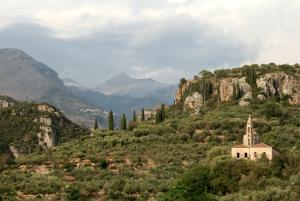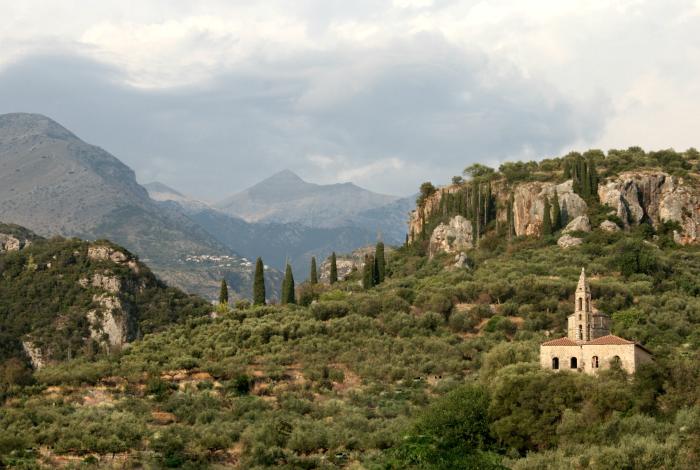Category: Landscape Photography
Post Type:
Photography
Mixed Media: None | Cropped just a tad
Pays
one point
and 2 member cents.





© Copyright 2024. avmurray All rights reserved.
avmurray has granted FanStory.com, its affiliates and its syndicates non-exclusive rights to display this work.
Posted: September 13, 2011
      |
The hills of Kardamili
Landscape around Old Kardamili
by avmurray
Interested in this? Contact The Artist
You can own this. Offers accepted. Information
This is the landscape you see behind and beside Old Kardimili. This is the second photo I send you where it seems to be a cloudy day, but the clouds were always just hanging over the high mountains of Taigetes and never reached us. We had nice weather and sunshine all the time apart from one day. To the right you would find both Kardimili and its old part of the town. The church you see in this photo is Agia Spiridon, a part of Old Kardamili, and the far away village is Tseria.
Kardamili during Ancient Greece
The village is first mentioned by the ancient poet Homer at around 1200 BC: he tells of how the area was offered by Agamemnon, Spartan leader of the Greeks in the battle against Troy, as a dowry to Achilles, who was instrumental in the victory of the famous war. At that time, Kardamili was the main port of the powerful ancient Greek city-state of Sparta; its acropolis or citadel was located on the steep hill that faces the sea just behind today's village. Local legend has it that the tombs of Castor and Pollux �?? twin brothers of the beautiful Helen of Troy �?? are today found in Old Kardamili. And, according to ancient scripts written by geographer Pausanias, many temples and statues decorated the town and there was a seaside shrine dedicated to the daughter of Nereus, Nirides, who, according to ancient Greek mythology, emerged from the sea in order to watch Piros (son of Achilles) pass through on his way to Sparta to wed Hermione, the daughter of King Menelaus.
Kardamili during the Roman Empire and Middle Ages
Greece prospered under Rome, but when the mighty Roman Empire was finally split into two, the country fell into the Eastern or Byzantine half. This Eastern Roman Empire was Christian, its official language was Greek, and its capital was in Constantinople (Turkey). Byzantine churches were built in villages all over the Empire, including the Peloponnese, and some of these can still be seen today in the neighboring villages of Nomitsi and Platsa. With the conquest of Constantinople during the Fourth Crusade in 1249 however, the Franks, led by the Villehardouins, came to occupy the Mani. Near Agamemnon's ancient Sparta, they took residence at the magnificent palace of Mistra, considered as the second most important city in the Empire after Constantinople. This was the last centre of Byzantine scholarship and the primary influence of the Italian Renaissance.
Kardamili from the late Middle Ages to the early 19th century
The Byzantine Empire eventually disintegrated, leaving the area of Greece to be invaded by the Turks, and the Peloponnese to fall under the rule of the Ottoman Empire in 1453. Inaccessible and remote, the Mani however kept itself free from the oppression of the Turks: the Maniots continued to bear arms and refused to pay levies and taxes imposed by the Ottomans. They survived by becoming pirates. Closely-knit clans evolved, and these were much like those of old Scotland �?? united by blood and very ferocious. In Kardamili, the most powerful clan was the Troupakis-Mourtzinos: from their fortified tower-houses in Old Kardamili they ruled over the area for two centuries and played a leading role in the Greek War of Independence, when in 1821 Greece was finally freed from the Turks.
Camera Model Canon EOS 400D DIGITAL
Shooting Date/Time 03.09.2011 17:40:49
Shooting Mode Auto
Tv( Shutter Speed ) 1/320
Av( Aperture Value ) 13.0
ISO Speed 400
Lens EF-S18-55mm f/3.5-5.6
Focal Length 55.0 mm
Image Quality Normal
by avmurray Interested in this? Contact The Artist
Kardamili during Ancient Greece
The village is first mentioned by the ancient poet Homer at around 1200 BC: he tells of how the area was offered by Agamemnon, Spartan leader of the Greeks in the battle against Troy, as a dowry to Achilles, who was instrumental in the victory of the famous war. At that time, Kardamili was the main port of the powerful ancient Greek city-state of Sparta; its acropolis or citadel was located on the steep hill that faces the sea just behind today's village. Local legend has it that the tombs of Castor and Pollux �?? twin brothers of the beautiful Helen of Troy �?? are today found in Old Kardamili. And, according to ancient scripts written by geographer Pausanias, many temples and statues decorated the town and there was a seaside shrine dedicated to the daughter of Nereus, Nirides, who, according to ancient Greek mythology, emerged from the sea in order to watch Piros (son of Achilles) pass through on his way to Sparta to wed Hermione, the daughter of King Menelaus.
Kardamili during the Roman Empire and Middle Ages
Greece prospered under Rome, but when the mighty Roman Empire was finally split into two, the country fell into the Eastern or Byzantine half. This Eastern Roman Empire was Christian, its official language was Greek, and its capital was in Constantinople (Turkey). Byzantine churches were built in villages all over the Empire, including the Peloponnese, and some of these can still be seen today in the neighboring villages of Nomitsi and Platsa. With the conquest of Constantinople during the Fourth Crusade in 1249 however, the Franks, led by the Villehardouins, came to occupy the Mani. Near Agamemnon's ancient Sparta, they took residence at the magnificent palace of Mistra, considered as the second most important city in the Empire after Constantinople. This was the last centre of Byzantine scholarship and the primary influence of the Italian Renaissance.
Kardamili from the late Middle Ages to the early 19th century
The Byzantine Empire eventually disintegrated, leaving the area of Greece to be invaded by the Turks, and the Peloponnese to fall under the rule of the Ottoman Empire in 1453. Inaccessible and remote, the Mani however kept itself free from the oppression of the Turks: the Maniots continued to bear arms and refused to pay levies and taxes imposed by the Ottomans. They survived by becoming pirates. Closely-knit clans evolved, and these were much like those of old Scotland �?? united by blood and very ferocious. In Kardamili, the most powerful clan was the Troupakis-Mourtzinos: from their fortified tower-houses in Old Kardamili they ruled over the area for two centuries and played a leading role in the Greek War of Independence, when in 1821 Greece was finally freed from the Turks.
Camera Model Canon EOS 400D DIGITAL
Shooting Date/Time 03.09.2011 17:40:49
Shooting Mode Auto
Tv( Shutter Speed ) 1/320
Av( Aperture Value ) 13.0
ISO Speed 400
Lens EF-S18-55mm f/3.5-5.6
Focal Length 55.0 mm
Image Quality Normal
Mixed Media: None | Cropped just a tad
 Recognized |


Landscape around Old Kardamili
by avmurray

You need to login or register to write reviews. It's quick! We only ask four questions to new members.
© Copyright 2024. avmurray All rights reserved.
avmurray has granted FanStory.com, its affiliates and its syndicates non-exclusive rights to display this work.


